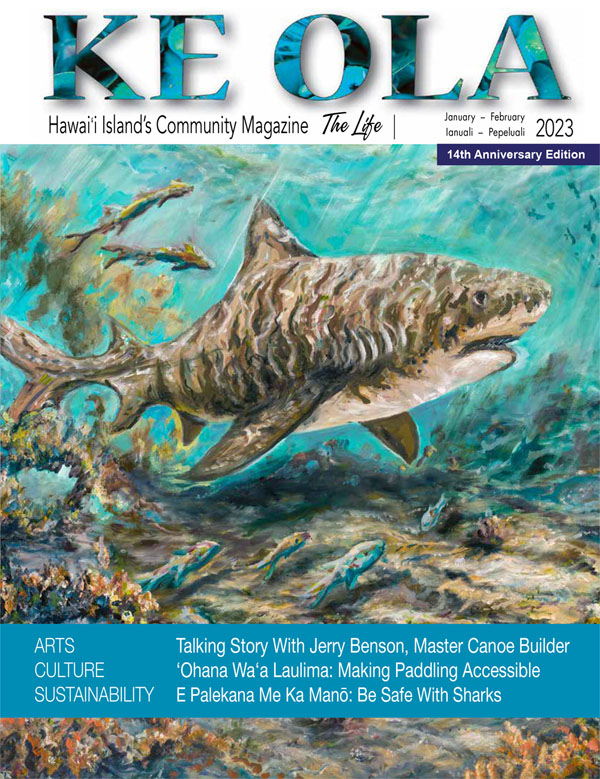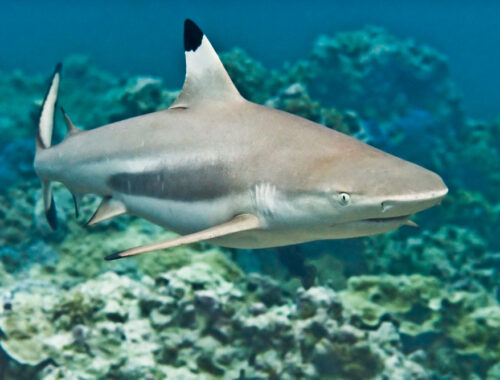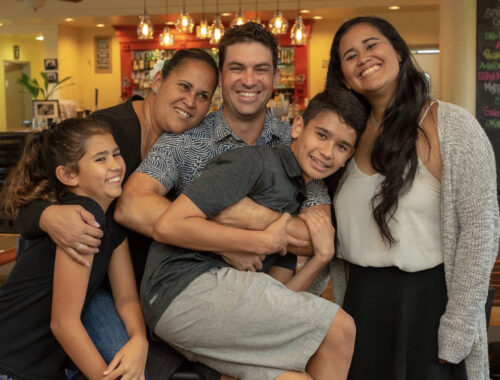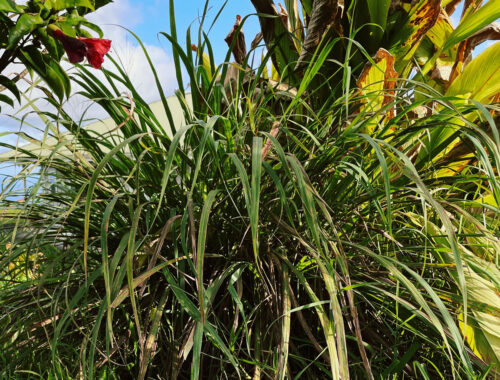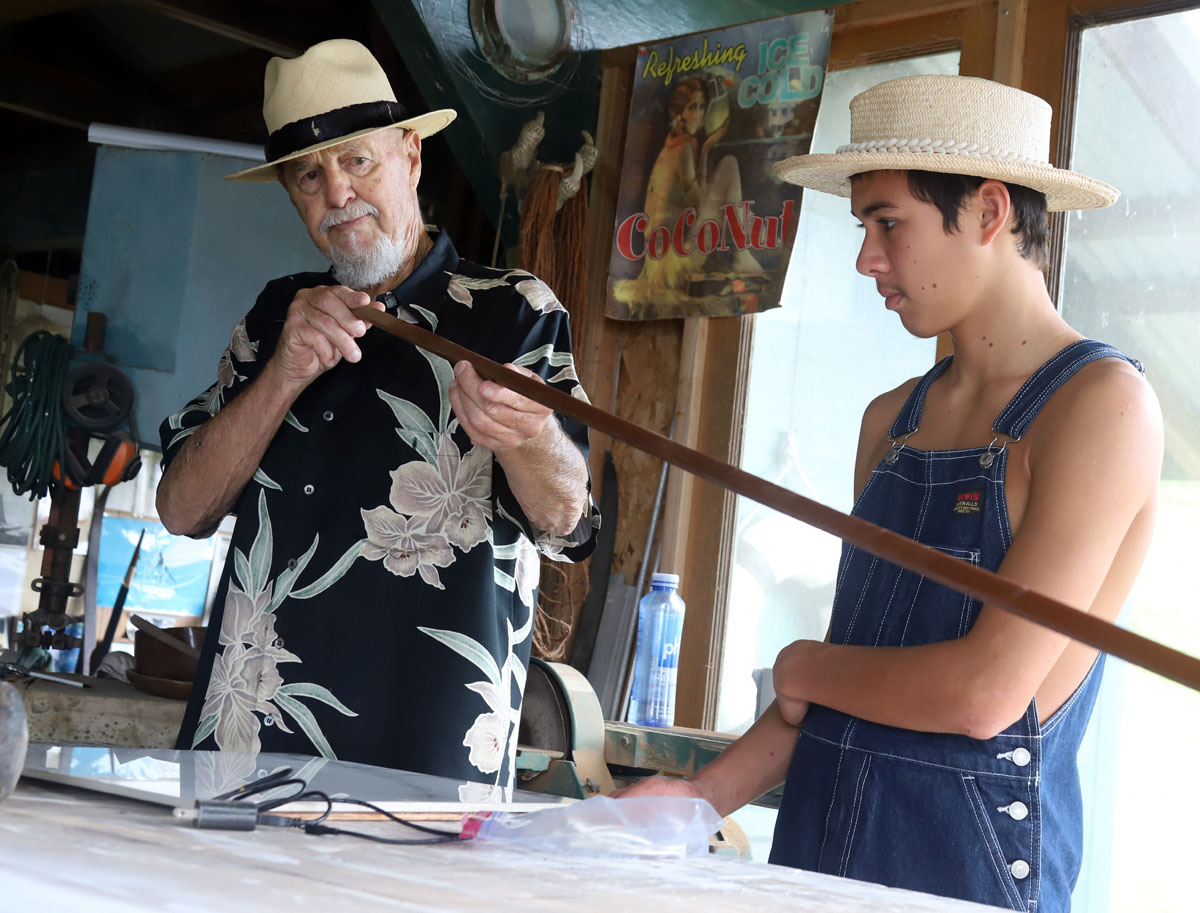
Talking Story With Jerry Benson, Master Canoe Builder

By Mary L. Moody
When I first met Jerry and Leina‘ala Benson in October 2011, I was unaware that their neighbor and good friend, Herb Kāne, had died earlier that year, in March. Having recently moved to the island from my native California, I also didn’t have a clue who that legendary person was. Throughout my relationship with the Bensons, however, I would come to learn about Herb’s partnership with Jerry, how it was a powerful part of the Hawaiian cultural renaissance in the 1970s, and the legend that Jerry himself has become.
As part of my kuleana (responsibility) to the ‘ohana (family) I worked with, I would take a crew of coffee pickers up to the Benson farm every other week. I would stand there on the slopes of Mauna Loa, with the sun still rising and a burlap bag at my feet picking coffee cherry. Leina‘ala (Lei) would pick alongside me and we would soon be joined by Jerry. They were both 67 at that time, and showed no signs of slowing down. As each of us engaged with our own relationship to the ‘āina, (land) I began to understand aloha—sharing of breath and life.
The Bensons’ paradise is nestled high in the ‘ōhi‘a forest atop Kealakekua Bay. The house is built from Jerry’s hands and imagination, decked out with polished ‘ōhi‘a posts. It feels like you’re in the belly of an ancient ship, with remnants of sea relics pridefully placed around the home.
Jerry would always generously invite me to their lānai (deck) after I had my fill of cherry picking, as smoky jazz simmered through the screen door. His arms covered in tattoos of sharks and canoes, he would cross them as he would rock back and forth on his hand-built rocking chair. I took it all in with awe as I sat on the yellow sofa below the carved plaque that displayed the farmʻs name, Kupaianaha.
Over the years, we’ve moved beyond the lānai, surrounded by koa paddles, custom built furniture, and countless original paintings by their friend, Herb Kāne. Lei and Jerry are getting older now, so I make sure I’m the one cooking the food when we visit and make sure to mālama (take care). Jerry sits on the couch facing the expansive view. I feel a need to start capturing these moments, so I ask him if I can record our talk story sessions. I begin by asking him how he got into canoe making.
“I started on my journey by making surfboards. Shaping them, developing an eye, working with tools, and fiberglass, are skills you need to develop to continue on that path,” he says. “I worked in a number of surfboard shops, and also some boat shops. I ended up at a canoe shop on Pi‘ikoi Street in Honolulu making four-and six-man racing canoes. This is where I built my first fiberglass, 22-foot, four-man canoe. It was perfect, as I lived in a beach house at Kawela Bay on the North Shore. That canoe got me hooked.”
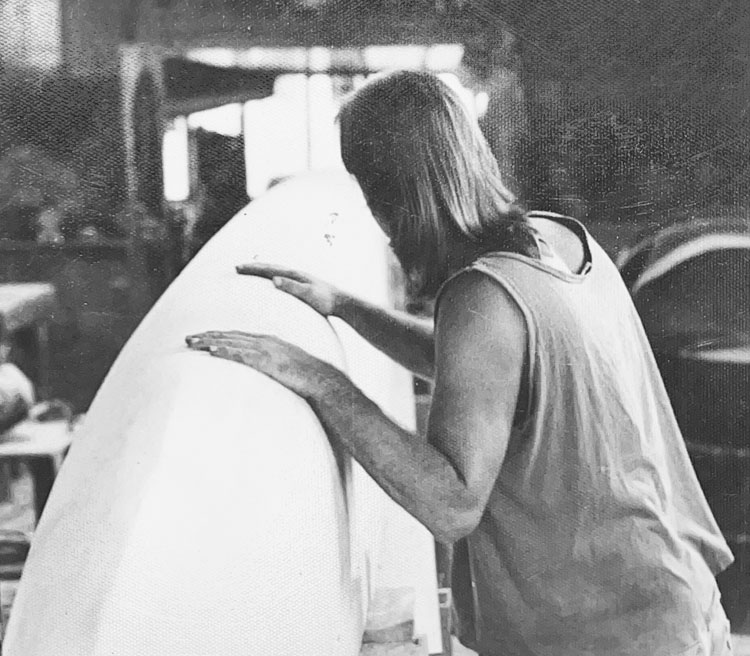
Thinking about the stories, and his legacy, I ask him what he wants to be most remembered for. “Mainly, that I was an especially good sailing canoe designer.” Benson canoe designs are legendary and he beams when I ask him about the canoe business he ran for decades. “Later I moved to Kona and started my own canoe shop. I was making canoes for the local canoe clubs and also three-and-four-man canoes for individual enthusiasts. Herb Kāne, the Hawaiian artist and designer of the first 60-foot voyaging canoe, Hōkūle‘a, moved to Kona and we decided to go into business together, and Kāne & Benson canoes was established. That was more than 45 years ago. We made more than 100 canoes.” He pauses and adds thoughtfully, “I learned a lot from Herb. He would design the canoes and I would make the molds and build them. Hōkūle‘a was the catalyst for a revival, a whole renaissance in canoe sailing.”
Jerry then explains what motivated Herb to come up with the voyaging design. “He wanted to recreate a voyaging canoe that would disprove what various anthropologists thought about how the different island groups were populated: that it was by accidental drift,” he says with a little irony in his voice. “The Polynesian people say that they sailed to these different places and provisioned up as they went. They did it on purpose, and some of it was against prevailing winds. Herb wanted to create a canoe as close to a design as he could come up with to the original measurements, size, and looks of an ancient canoe, and they built the Hōkūle‘a. That canoe has sailed many thousands of miles and of course has already been all the way around the world now.”
It wasn’t smooth sailing for the Hōkūle‘a in the beginning. Jerry recalls, “I went in and did a complete rebuild of that canoe after it turned over with the whole crew that one time,” he says with sadness in his voice. “I feel so fortunate to have known Herb and to have had the opportunity to learn so much from him. I guess, at this point in time, you would call me a canoe freak. I love canoes and will never stop designing and building. I no longer do the production I once did, but am presently building a 21-foot, three-man fiberglass canoe for my mo‘opuna [grandchild].”
Whenever the Bensons’ grandchildren come to visit, I like to ask them how Jerry has inspired them in their lives. Ka‘iwa, 16, responded that he’s always admired the quality of his grandpa’s work and his artistic mindset. Like Jerry, he is a talented surfer and spends his free time drawing and spray painting. His sister, Leina‘ala, 14, noted that her favorite thing about her grandad is that he lives life by his own set of rules. Of course, he also lets her eat ice cream for breakfast.
Kawela Benson, 28, recalls, “Growing up, seeing my grandpa ho‘omau [persevere] in his projects has always helped push and inspire me in life. My favorite memories are when he would take me to his shop and I would get to watch him build these beautiful masterpieces.”
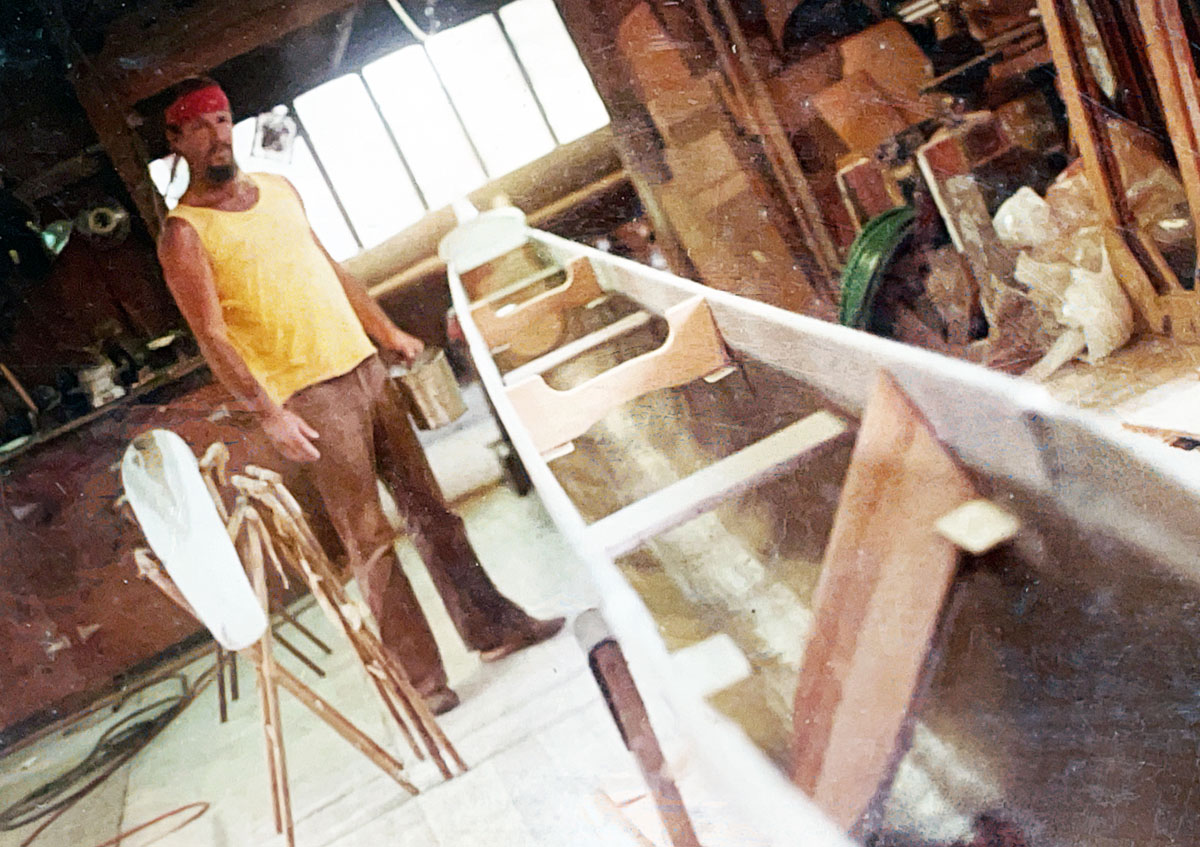
The Making of the Makali‘i
Jerry says a favorite project to date has been a community project led by the Bertelmann family, Chadd Paishon, and many others from the Waimea area. “Another voyaging canoe I got involved with was the Makali‘i, a 54-footer. Building the Makali‘i was the most beautiful, satisfying, and fun canoe I ever did. I had made the mold and had two hulls in front of my shop when they came to me with the idea of building their own voyaging canoe. The hulls went to Waimea, and with very little money and a lot of enthusiasm, we started. My brother and I led the project as we were the only ones who knew anything about fiberglass and boats. We basically got her going in the beginning of construction. Kind of proud of that. It’s faster than the other ones. I like that.”
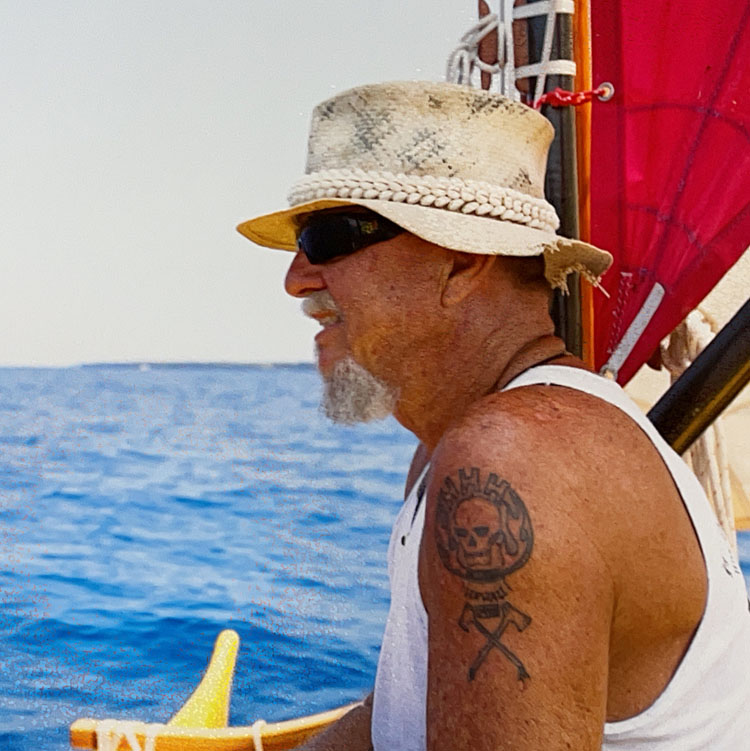
Chadd Paishon shed more light on the Makali‘i as a movement, saying, “As we continue to sail and share all that has been shared with us, we carry on the work that was originally envisioned by Clay Bertelmann and everyone else. Ola, it lives. It’s not left to a book, not left to just stories. When I was growing up thatʻs all we had were the stories of voyaging, ‘cause there wasn’t a voyaging canoe yet being built in Hawai‘i until Hōkūle‘a.”
It’s clear that Jerry holds himself confidently, and rightly so, as his contributions to canoe sailing in Hawai‘i have been monumental. I ask how it feels to be a part of the genealogy of these legendary vessels. He hesitates as he considers the honor. “I feel like I’m fortunate to have been involved in it and been able to work on these beautiful canoes that have sailed all over the place. The men and women of Waimea were fantastic. Together we brought the Makali‘i into existence. A beautiful, strong, and fast canoe. She has been many thousands of miles throughout Polynesia and Micronesia. We started Makali‘i over 20 years ago, and she is still going strong with a very successful sailing and Hawaiian educational program for local youth.”
Chadd also reflected on what it takes to make something as special as the Makali‘i come together. “It’s never about one person, itʻs always about all of us that come together. For me itʻs always honoring our kūpuna that came before us. ❖
